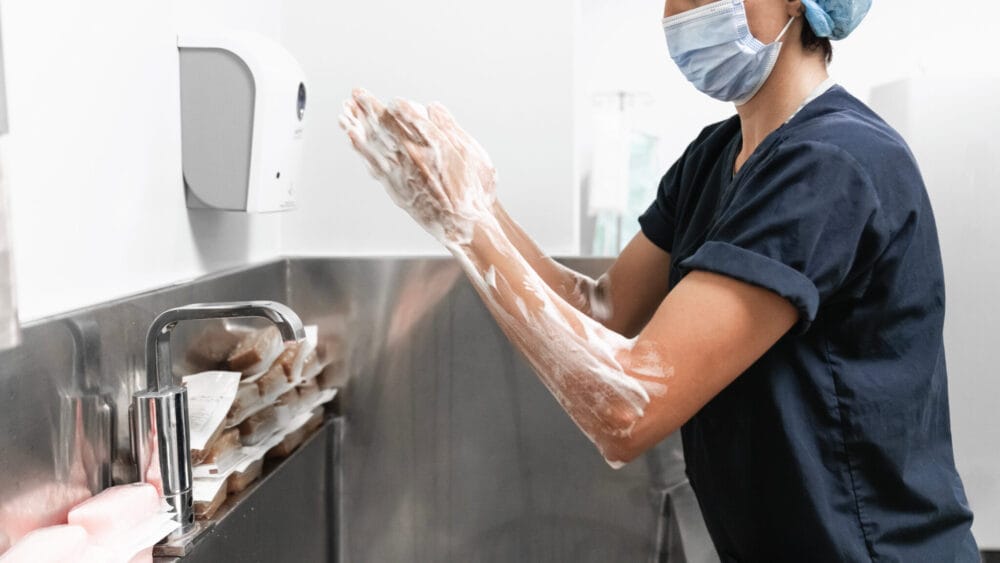
Scrub sinks are a crucial component of infection control in healthcare facilities, helping prevent the spread of infectious organisms to vulnerable patients.
The Evolution of Scrub Sinks
The evolution of scrub sinks aligns with advancements in hand hygiene, influenced by pioneers like Ignaz Semmelweis and Florence Nightingale, who highlighted the life-saving impact of handwashing.
Semmelweis, a researcher in Vienna, Austria, conducted studies in the mid-1800s demonstrating that maternal mortality rates dropped significantly when healthcare workers washed their hands between performing autopsies and entering delivery rooms.
During the same period, Florence Nightingale emphasized hand hygiene among nurses during the Crimean War, improving sanitary conditions and survival rates in battlefield hospitals.
From simple basins to modern hands-free sinks, scrub sinks have evolved to support effective hygiene practices.
The scrub sink environment plays an equally important role in infection control by influencing hygiene practices, minimizing contamination risks, and ensuring compliance with safety standards.
Read on for tips on designing an effective scrub sink environment for optimal infection control.
Choose the Right Location
Facility Guidelines Institute (FGI) guidelines state that operating room (OR) or surgical scrub sinks should be placed just outside each OR.
The handwashing area should be located out of the traffic path to reduce the risk of cross-contamination. Avoiding high-traffic areas also prevents water from splashing onto carts or other equipment being transported through the area.
Be sure to locate medication preparation and patient areas away from scrub sink alcoves.
Optimize for Ergonomics
Set up scrub stations to allow staff to perform handwashing comfortably and efficiently.
- Install surgical scrub sinks at a height that is comfortable for most staff.
- Choose large, deep sinks that allow thorough scrubbing without touching the sides or bottom.
- Place shelves and waste bins within reach but outside the splash zone.
- Ensure adequate lighting without excessive glare, allowing staff to see their hands and arms clearly during handwashing.
When designing the scrub space, consider accommodating disabled staff by providing enough room to maneuver and adjustable height sinks to accommodate wheelchair users.
Materials and Layout Considerations
The scrub space is the final opportunity for healthcare staff to ensure proper hand hygiene and reduce the risk of transmitting infectious organisms before entering a high-risk environment. The scrub alcove should be resistant to microbes and easy to clean.
Floors, walls, and shelving should be smooth, non-porous, and resistant to damage from chemical cleaners. Antimicrobial surfaces or coatings can further limit pathogen growth.
Supplies such as brushes, towels, and masks should be placed outside the splash zone but within easy reach. No-touch trash bins further help reduce the risk of cross-contamination.
Ensure proper drainage and prevent standing water by sloping counters toward the sink.
An appropriate ventilation system is a key component of the scrub area to reduce moisture buildup on walls and surfaces.
Surgical Scrub Sink Design
Scrub sink design is vital in healthcare to maintain hygiene and prevent cross-contamination during handwashing in a surgical setting.
Look for seamless designs with deep, sloped basins. The water outlet should be an appropriate distance above the sink’s bottom to allow space for handwashing without touching any part of the sink.
Choose sinks with integrated splash guards to reduce the risk of contamination. Splash guards help keep scrub supplies and surrounding areas clean.
Offset sink drains help prevent contaminated water in the drain from splashing back onto staff or sink surfaces.
Faucet Controls and Water Monitoring
Foot, knee, or elbow-controlled faucets have reduced the spread of infections and are now standard in hospitals. Infrared sensor-activated faucets became popular for further limiting pathogens, but by 2011, studies linked them to infectious outbreaks from bacteria like Pseudomonas aeruginosa and Legionella.
The concern was that infrared sensors allowed biofilm to develop. Though electronic faucets harbor more pathogens than hands-free faucets, thermostatic mixing valves (TMVs) may contribute by creating an environment for bacterial growth.
To reduce the risk of contamination, the American Society for Healthcare Engineering (ASHE) and the Association for Professionals in Infection Control and Epidemiology (APIC) suggest that healthcare facilities purge faucets at least every 12 hours. The Association of periOperative Registered Nurses (AORN) advises regularly monitoring water quality and components for contamination.
Key Takeaway
In healthcare facilities, designing a surgical scrub sink environment that prioritizes functionality for all staff, proper hygiene, and sustained infection control is essential. Consider factors like location, ergonomics, materials, and sink design to create a space that supports efficient and effective handwashing while minimizing the risk of contamination.
InnerSpace offers Integro scrub sinks in single, double, and triple basin designs. These sinks are designed to meet healthcare criteria to prevent spread of infectious organisms throughout the hospital environment. Made with high-quality material, components and craftsmanship, these sinks will last a lifetime. Find a rep for more information, or request a quote today!
Additional Article References:
- https://www.ncbi.nlm.nih.gov/books/NBK144018/
- https://pmc.ncbi.nlm.nih.gov/articles/PMC11373583/
- https://www.cdc.gov/infection-control/hcp/core-practices/index.html
- https://www.healthfacilityguidelines.com/StandardComponents/ItemDetails/Scrub-Up-Gowning-8m2
- https://www.cambridge.org/core/journals/infection-control-and-hospital-epidemiology/article/abs/impact-of-electronic-faucets-and-water-quality-on-the-occurrence-of-pseudomonas-aeruginosa-in-water-a-multihospital-study/0B3BFAAAAF09C350600957A71E34A54E
- https://www.cambridge.org/core/journals/infection-control-and-hospital-epidemiology/article/abs/electroniceye-faucets-legionella-species-contamination-in-healthcare-settings/5E1A7B3DB6C652C4D4985B9B98C963A1

Cindy Blye
Content WriterCindy Blye, BSN, RN, CCM is a Registered Nurse and Certified Case Manager. She is an Alumni of West Virginia University School of Nursing (BSN), and a member of the Association of Health Care Journalists and The Authors Guild.
